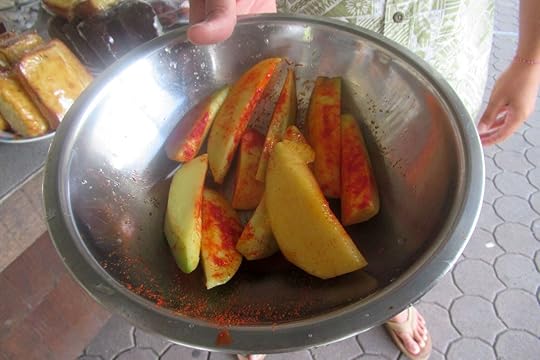Matador Network's Blog, page 903
March 16, 2020
John Oliver gives space to complain

It’s a sensitive time around the world right now. As a pandemic grips nearly every nation, and our daily lives are being altered for the foreseeable future, it’s easy to feel frustrated, angry, and in desperate need of some cathartic venting. However, with thousands who died from the virus and thousands more infected, it can seem inappropriate to complain about your canceled St. Patrick’s Day party, or your favorite restaurant temporarily closing. John Oliver, however, is encouraging you to do just that: Complain.
On his most recent episode of Last Week Tonight, Oliver urges viewers to give themselves 30 seconds to selfishly complain about how the coronavirus has ruined their lives.
“I know this disruption to your life is annoying,” he said, “and it’s okay to be disappointed or even irritated. Because you can’t go out, your favorite events were postponed, or a trip you planned fell through,” Oliver explained. “But you’ve got to get that out of your system. Let’s put 30 seconds on the clock right now, during which everyone can be selfishly angry about things that didn’t want canceled or postponed.”
A little complaining can be cathartic. Once you’re done, suck it up and deal with it.
“Take care of yourself,” he went on to say, “take care of each other, and we will be back in some form sometime in the future. We also have a real responsibility to one another right now, because the choices we make in the coming days and weeks will conjugate directly to how bad this crisis gets.” 

More like this: Racist panic over coronavirus will not help the people of China
The post John Oliver urges people to take 30 seconds to selfishly complain about the coronavirus appeared first on Matador Network.

What is Mongolian throat slinging?

I was in college the first time I heard throat singing. A friend, who was then enrolled at the Berklee College of Music, had learned of a bitonal chanting technique from Mongolia and spent months trying to master it before attempting a demonstration one night over dinner.
What resulted was a chorus of grunts sounding from a quickly reddening face. It was a far cry from the Youtube clip we pulled up after, which featured a throat singer belting guttural yet smooth, almost vibrational, harmonies into an empty steppe like a human didgeridoo. It was a sound unlike any I had heard a person produce, made up of notes I never even knew existed.
Overtone singing, or höömii as it’s called in Mongolia, enables vocalists to create multiple pitches at once by manipulating their mouths and throats. They’re then able to sustain these sounds for extended periods of time by using a circular breathing technique.
“If you sit down at a piano and play all the keys, they’re going to be tuned the same…that’s the harmony basically all Western music is based on,” says Andrew Colwell, who studied höömii in Mongolia for two years before getting his PhD in ethnomusicology at Wesleyan. “With throat singing, when you do that melodic overtone, it’s not based on the same tuning: It’s based on the harmonic series. So the intervals, the spaces between the notes that you can make, don’t exactly align with the notes on the piano.”
The effect is powerful, haunting even, yet I managed to forget about Mongolian throat singing after that night. Until, several years later, there it was in the mainstream.
In 2014, Mongolian folk band Altan Urag found a Western audience after featuring on the soundtrack for Netflix’s Marco Polo. That audience grew considerably last April when Mongolian metal band The Hu’s songs “Wolf Totem” and “Yuve Yuve Yu” debuted on Billboard. (“Yuve Yuve Yu” currently has more than 39 million views on Youtube, “Wolf Totem” over 27 million.)
Though bands like The Hu and Altan Urag, who wrote a song with Colwell in 2007, have helped familiarize international listeners with höömii techniques, early throat singing was a private, personal practice that originated among male herders in western Mongolia and southern Russian Siberia, around the Altai Mountains.
While distinct, höömii and khöömei, the predominant throat-singing style in the Russian republic of Tuva, use the same basic techniques. Both methods of communing with nature, they’re meant to mimic the surrounding landscape: whistling winds, howling wildlife, and babbling streams.
Overtone singing is believed to have originated in Central Asia, but throat-singing customs extend beyond the border of Mongolia and Russia. Notably, Inuk artists like Tanya Tagaq, whose 2014 album Animism beat out artists like Drake and Arcade Fire for Canada’s Polaris Prize, have also brought Inuit throat games into the limelight.
Unlike in Mongolia and Siberia, where throat singing was considered taboo for women, in northern Canada, traditional throat singing was performed exclusively by Inuit women, often in groups. Sessions were held while men were off hunting during winter, sometimes for weeks at a time, manifesting more like breathing games than singing exercises.
Now extinct, a similar sharp, breathy style of vocal games called rekkukara has also been linked to the Ainu people of Hokkaido in Japan. Elsewhere, the Xhosa people of Bantu origins in South Africa have their own overtone singing style called eefing.
Yet unlike rekkukara and Inuit vocal games, which were banned by Christian missionaries and only began making a comeback in the 1980s, Mongolian throat singing flourished in the 20th century, first under Soviet rule and later after the USSR fell.
Mongolia won its independence from China in 1921. Shortly after, it became the Soviet Union’s first satellite state and remained under Soviet control for 70 years. In that time, the USSR’s socialist movement targeted the “backwards” customs of the states within its sphere of influence, Mongolia among them. Restrictions were placed on cultural imports, including Western music, and Mongolian singers were sent to the Eastern Bloc to study opera.
Yet, ironically, in throat singing’s case, “socialism became one of the main reasons it was adapted to the stage and professionalized, and then promoted overseas,” says Colwell.
Beginning in the 1930s and ‘40s, höömii shifted from a herder’s practice into a national folk art. Then, in the 1950s, it “very quickly became a market of national culture.”
To promote its values, the Soviet Union would send cultural delegates from the states it controlled to international festivals, where they were expected to perform as proof of the USSR’s successful cultural development programs. In 1950, a vocalist named Tsedee became the first professional throat singer in Mongolia, performing höömii on stage for the first time in Ulaanbaatar four years later. The following year saw the first international höömii performance.
It was around the mid-century that höömii singers also started playing with folk melodies, which led to experimentation with international influences over the next couple of decades. Classical came first. In the 1960s and ‘70s, Sundui, a höömiich who author and ethnomusicologist Carole Pegg calls the founder of overtone singing’s “modern classical form,” studied the bel canto operatic style and tackled composers like Tchaikovsky.
Awareness of the vocal technique spread throughout Mongolia and Siberia in the first half of the 20th century. Then in the latter half, it headed West, crossing paths with even more genres.
Höömii first arrived on the international scene in the 1980s when vocalists began experimenting with the band format. In 1996, ethnomusicologist and Dartmouth professor Theodore Levin published a seminal text on Central Asian music stylings. A decade later, he followed it up with Where Rivers and Mountains Sing: Soun, Music, and Nomadism in Tuva, which documented his time with members of the Tuvan band Huun-Huur-Tu, who also collaborated with Frank Zappa and other international artists in the early 1990s, not long after the Soviet Union dissolved.
By the turn of the millenium, Tuvan throat singing had solidified its place in Western pop culture’s periphery. A 1999 documentary entitled Genghis Blues, which follows American blues musician Paul Pena on his travels in Tuva, became an instant cult classic among musicologists. The film shows Pena, who penned the 1997 hit “Jet Airliner” for the Steve Miller Band and played with the likes of B.B. King, becoming the first American to participate in, and win, an annual Tuvan throat-singing competition. It was nominated for an Academy Award in 2000.
Thanks in part to a sizable expat community that formed in Germany after the fall of socialism, says Colwell, Mongolian höömii began gaining traction in its own right around 2000, paving the way for bands like The Hu to showcase their music heritage.
It’s tempting to say that traditional höömii has changed over the past century, but in reality, change has been a cornerstone of the practice ever since it was institutionalized. Because it started so individually, a practice shared loosely among herders, “the exemplars of what we call traditional höömii today are people like Sundui and the first people to perform on stage, who [were] themselves experimenting with techniques and genres,” says Colwell.
Adaptable and far-reaching, yes, höömii is nonetheless a proud Mongolian cultural export that the nation not only claims but is also prepared to defend. This was evidenced in 2009 when China registered throat singing with UNESCO as an example of its own Intangible Cultural Heritage, prompting outcry from both Mongolians and Tuvans. (UNESCO has since updated the inscription to reflect khöömei’s Mongolian origins.)
After a paradoxical century in which the Soviet socialist agenda helped preserve Mongolian heritage and UNESCO mistakenly discredited the originators of the practice, it remains to be seen what creative opportunities are in store for höömii in its post-Billboard era.
In a way, it’s difficult to conceive of a more fitting musical mashup than gruff, orchestral overtone vocals and heavy-metal instrumentals, as The Hu’s millions of viewers would likely attest to. But if the last 100 years have taught us anything about Mongolian music, it’s that we can all look forward to what the next hundred will inspire. 

More like this: The Golden Eagle Festival is one of the top experiences to have in Mongolia
The post How Mongolian throat singing made it onto the Billboard charts appeared first on Matador Network.

LVMH making hand sanitizer

French luxury brand company LVMH is stepping up to make hand sanitizer more widely available across France. On Sunday, the company announced that it will be repurposing its perfume and cosmetics production sites to create hydroalcoholic gel for hand sanitizer.
In a statement, the company said, “Through this initiative, LVMH intends to help address the risk of a lack of product in France and enable a greater number of people to continue to take the right action to protect themselves from the spread of the virus. LVMH will continue to honour this commitment for as long as necessary, in connection with the French health authorities.”
The hand sanitizer will be made available for free to French authorities as well as to Assistance Publique-Hôpitaux de Paris, the largest hospital system in Europe that treats more than eight million patients each year.
The campaign to produce more hand sanitizer comes at a crucial time, as there is currently a global shortage as people around the world are stocking up en masse. And France isn’t the only place getting creative to solve the shortage. According to New York Governor Andrew Cuomo, the state will begin employing prison inmates in an effort to produce its own hand sanitizer. 

More like this: No, you can’t make hand sanitizer with vodka
The post French luxury brand LVMH is using its factories to make hand sanitizer appeared first on Matador Network.

Spain, Italy keeping busy COVID-19

The coronavirus has sent Spain into a nationwide near-lockdown, but that’s not discouraging people from finding creative ways to get their daily dose of fitness. One personal trainer is helping his neighbors stay in shape by conducting a group workout class from the roof of his apartment building in Seville. The instructor, named Gonzalo, has been standing on the complex’s rooftop and coaching residents who participate on their separate balconies, doing exercises like jumping jacks and squats.
View this post on InstagramA post shared by Good News Movement (@goodnews_movement) on Mar 14, 2020 at 3:00pm PDT
Sano Sevilla Los Bermejales, the training center where Gonzalo works, said, “This is how @gonzalo_gbroto is passing the time with his neighbors. This is the spirit of Sano Sevilla Los Bermejales. Despite such adverse circumstances, we’re going to get the best out of you.”
According to Luis Javier, a manager at the gym, Gonzalo organized the neighborly workout using WhatsApp.
“All the neighbors were having a hard time and sad,” he said, “but now, every day they are looking forward to the time for their training. It is a healthy idea, which helps people feel much better and face the situation in Spain in a positive way.”
View this post on InstagramA post shared by Good News Movement (@goodnews_movement) on Mar 15, 2020 at 10:58am PDT
And Seville isn’t stopping at exercise. Another viral video shows Seville residents in lockdown entertaining themselves with a game of bingo. An MC shouted numbers from his window, while players followed along from their own apartments.
View this post on InstagramA post shared by Good News Movement (@goodnews_movement) on Mar 13, 2020 at 3:32pm PDT
Meanwhile, in a similarly locked down Italy, people in Milan are staying positive by dancing on their balconies to “Life is Beautiful.” 

More like this: Racist panic over coronavirus will not help the people of China
The post During lockdown, people get creative with workouts, bingo, and dance sessions appeared first on Matador Network.

Everest climbing permits suspended

There will be no traffic jam on Mount Everest this year. The government of Nepal announced on Friday that due to fears of COVID-19 being spread by arriving climbers, it would suspend all climbing permits for Mount Everest and all other peaks in the country. The announcement followed a Thursday order by China banning expeditions from its side of the world’s highest peak. The move comes as the annual climbing season was set to kick off next month, leaving many sherpas and mountain guides unemployed during the time period in which they earn the vast majority of their income.
Permits purchased by Everest climbers can cost up to $11,000 per climber, leaving Nepal, one of Asia’s poorest nations, without one of its most consistent sources of revenue. Many climbers coming from abroad pay nearly $100,000 for a guided experience to summit the world’s highest mountain. Nepal has had one confirmed case of the novel coronavirus, and canceling the climbing season is a preventative measure to keep foreigners from bringing additional cases and putting themselves at risk at high altitudes. The country has also suspended its visa on arrival system for foreign tourists and will require all foreign arrivals to adhere to a 14-day quarantine.
Many Everest tour operators, including California-based Alpenglow Expeditions, canceled their 2020 Everest trips following China’s decision on Thursday, and operators around the globe had seen increased cancellations even before the announcements. “Our concern would be getting someone stricken by the virus safely off the mountain,” said Alpenglow Expeditions CEO Adrian Ballinger in a statement on the company’s website. “Receiving appropriate medical attention at a remote site like this would be very challenging, and getting someone home, while ill, a logistical nightmare.”
It is unknown when the Nepalese government will begin issuing permits for the country’s other popular peaks including Annapurna, Kanchenjunga, and Lhotse, among others. 

More like this: The world’s foremost sea stack climber will show you Ireland’s wild side
The post Everest closes to climbers, Nepal suspends tourist visas appeared first on Matador Network.

March 13, 2020
Disney closes parks for coronavirus

In response to the coronavirus outbreak, Disney is closing all of its theme parks worldwide starting on March 16. Earlier this year Disney closed its parks in Asia, and in the next few days, its properties in Europe and the US will follow suit.
Disneyland in California will close its doors after March 13 while Disney World in Florida and Disneyland Paris will close at the end of the day on March 15. Hotels at both of these resorts will remain open indefinitely, but Disneyland California’s hotels will close after March 16. Disney Cruise Line will also be suspending operations starting March 14. All closures and suspensions are scheduled to remain in effect until the end of March.
Universal Studios in Hollywood and Orlando will also be closed from March 14 to March 28, 2020, and from March 16 to March 31, 2020, respectively. Hotels at both resorts will remain open.
Guests who had booked a stay at the resort during this time will be entirely refunded. For those wishing to reschedule their travel to Disney resorts after the parks reopen, Disney will be waiving the change and cancellation fees for resort packages booked directly with Disney, all the way through June 2020. 

More like this: Everything travelers need to know about the coronavirus outbreak
The post Disney is closing all its theme parks due to the coronavirus pandemic appeared first on Matador Network.

Best recent Irish authors and books

Spending the day in an overcrowded pub doesn’t seem to be on anyone’s agenda for St. Patrick’s Day in 2020. So, so long as we’re all staying home, a good Irish book might be the best way to celebrate the holiday. But celebrating Irish culture with some literature does not necessarily mean that you have to dive into Joyce, Becket, and Heaney. Although staples of the world of writing in Ireland, they are not what one would call “light reads.” For a peek at the rich and excellent modern Irish literary scene, go to your local bookstore or your neighborhood library and get yourself one or more of the following books.
Dublin Murder Squad series by Tana French

Photo: Penguin Random House
Tana French was born in the US, but has been living in Ireland since the 1990s so her knowledge of the country and its people, language, and economic and social situation is very intimate — and it shows in her novels. The six books of the Dublin Murder Squad series (In the Woods, The Likeness, Faithful Place, Broken Harbour, The Secret Place, The Trespasser) are filled with captivating characters and plots that are described in such detail that it’s hard not to be pulled into French’s dark, dreary stories of murders. Those who know Dublin will be glad to see the atmosphere of its neighborhoods so perfectly captured, and those who don’t will get to discover the Republic’s capital city beyond its clichés of pubs and buskers, and the green lawns of Trinity College. The success of the series has led to the first two novels to be adapted to television, so after you’ve read them check out Dublin Murders on Amazon Prime to contrast and compare.
Milkman by Ana Burns

Photo: The Booker Prizes
Ana Burns’ Milkman won the Man Booker Prize in 2018 and for good reason — her novel is like nothing you’ve ever read. The story of a young woman who lives in what readers understand to be Belfast during the Troubles in the 1970s, Milkman is shrouded in mystery; none of the characters have names, the city where it is set is never mentioned, and the conflict and its actors are never explicitly identified. Just like for those who lived in Northern Ireland during this intense time period, everything is kept under wraps for fear of repercussions. Yet, Burns’ voice is such that we understand it all without the need for clarification. But the singular narration is not the only element that makes this novel gripping; by bringing forward the concepts of gender and power into the conflict, Burns shines a light on a side of the Troubles that you never even considered.
Himself by Jess Kidd

Photo: Jess Kidd
A dark mystery set in a part of the Republic of Ireland that’s ever hardly mentioned in popular culture, County Mayo, Himself is a thriller with a side of humor, romance, and even magic. Kidd’s novel tells the story of Mahony, a young and dashing man, who comes back to the small village of Mulderrig where he was born in search of his mother, whom he never knew. His arrival agitates the inhabitants and injects a dose of life in the sleepy village, but it comes at the price of unraveling nasty secrets that some would rather see buried deep forever.
Say Nothing by Patrick Radden Keefe

Photo: Penguin Random House
Probably the best explainer you’re ever going to read on the Troubles, Patrick Radden Keefe’s Say Nothing is a work of nonfiction that is just as much a page-turner as any detective novels. Detailed, chronological, and with a deep focus on some of the most charismatic people involved in the conflict, Keefe humanizes the conflict, including the perspectives of the Irish Republican Army and all the people of Northern Ireland. No matter your affiliations or opinions, you’ll understand the motivations of those involved in the conflict and feel the pain of those who had no choice but to live with it on a daily basis. If your knowledge of this part of Ireland’s history is a little fuzzy, pick up this New York Times bestseller and everything will be made crystal clear.
Normal People and Conversations with Friends by Sally Rooney

Photo: Penguin Random House
Sally Rooney’s accounts of the seemingly banal ways people in love — platonically and romantically — communicate are by turns intimate, uncomfortable, and disturbing. Rooney’s impeccably crafted tales of friendship, heartbreak, sex, dating, and affairs (sometimes set at Trinity College in Dublin) center on the tumultuous inner-lives of young women without casting their concerns, fears, and feelings as frivulous or shallow. Instead, Rooney treats her protagonists, and their sometimes twisted approaches to relationships with almost scientific attention. Something about her bleak view of love appeals to millennials; Rooney was one of most talked about writers of 2019.
Room by Emma Donoghue

Photo: Hachette Book Group
In 2015, everyone was talking about Emma Donoghue. Her 2010 international bestseller Room, a finalist for the Man Booker Prize, had been adapted into a film starring soon to be superstar Brie Larson, sweeping up both Golden Globe and Oscar nominations. But the Irish-Canadian writer, historian, and playwright had been producing award-winning literature for more than a decade. Her debut, Stir Fry, was a finalist for the Lambda Literary Award, a prize given to novels that celebrate LGBTQ themes. Her followup, Hood, won the Stonewall Book Award for literature. In 2009, she won the Lambda Literary Award for her novel The Sealed Letter.
Brooklyn by Colm Toibin

Photo: Penguin Random House
Colm Toibin’s tale of a Eilis Lacey, a young woman who leaves her small town in Ireland to find work in Brooklyn is romantic and moving. Eilis is on the brink of discovering the kind of woman she wants to be, and she turns out to be a surprisingly brave and compelling protagonist. Torn between her home, family, tradition, and a longing for adventure, she strikes out on her own at a time when independent women faced immense ridicule. Yet Eilis is resilient and confident, and it’s a real pleasure to follow her journey from Ireland to her destiny in the US. Life in the quaint but sometimes stifling villages of Ireland is a focus for Toibin but he balances charm with a healthy dose of realism.
Lost, Found, Remembered by Lyra McKee

Photo: Faber
On April 18, 2019, journalist Lyra McKee, in her characteristic curious and courageous manner, decided to check out a riot in Derry, which quickly turned violent. Protestors threw petrol bombs and lit cars on fire. McKee was shot in the head. She died at just 29 years old. McKee was an accomplished investigative journalist who focused on the aftermath of the Troubles, including teen suicides connected to that period. She also investigated the era’s many unsolved murders and in 2019 the Irish Times named her one of 10 rising stars of Irish writing. Before her death she had signed a two-book deal with Faber and Faber. On March 31, 2020, an anthology of her radically political work, which focused on the human consequences of the Troubles, will be released by Faber and Faber. The book, called Lost, Found, Remembered, will feature her unpublished work, lesser-known early articles, and her most beloved stories. Her first book, Angels with Blue Faces, a five-year investigation into the murder of a Parliament member by the Irish Republican Army, was released in 2019. 

More like this: 20 books we can’t wait to read in 2020
The post Modern Irish authors to read for a literary St. Patrick’s Day appeared first on Matador Network.

Guinness Storehouse guide in Dublin

The birthplace of the iconic black stuff, Dublin is a bucket-list destination for beer lovers around the world. Having a pint of Guinness in a cozy Dublin pub is the quickest way to imbue yourself in Irish craic. But to truly appreciate the 250-year history between the Guinness name and the city of Dublin, head to the Guinness Storehouse, the first stop for over a quarter of Dublin’s tourists. Beyond the Storehouse itself, the city has 751 pubs, so you don’t have to travel far between drinks. Here’s the lowdown on how to sip your way through Dublin’s best watering holes.
Start with the Guinness Storehouse

Photo: Anton_Ivanov/Shutterstock
This behemoth of a museum is where you can learn about the history of the “black gold,” as it’s known here, along with the influence of the Guinness name throughout Ireland. The self-guided tour starts with a replica of the 9,000-year-long lease signed by Arthur Guinness back in 1759 for the property. You’ll also learn what makes the Guinness flavor distinct (hint: it has to do with roasted barley). Winding your way up through the multi-level interactive museum is part history lesson, part science class. By the time you reach the fifth floor Guinness Academy, you’ll have a newfound appreciation for the craftsmanship that goes into each pint.
Speaking of pints, all tickets include a complimentary pour, so take a break here and put your bartending skills to the test. The moment you pick up your glass to the moment you serve a pint of Guinness is 119.5 seconds — very specific, perhaps, but a tip you’ll hear often as the brand is quite protective of its presentation. By the time you leave the fifth floor, you should know how to pour the perfect pint in these six essential steps:
1. Have a clean pint glass with the iconic harp logo
2. Hold pint at a 45-degree angle
3. Pull handle down and fill three-quarters full
4. Leave to settle
5. Top up by pushing handle backward
6. Serve with logo facing customer (yourself, in this circumstance)
Step seven, of course, involves pulling up a stool and sampling the goods.
Beyond the pour lesson, the museum charts the 260-year-old company’s radical developments in both production and marketing, from building their own railway lines and power plants to moving from wood to steel barrels. According to the videos and signage throughout the storehouse, the company’s modern vision is to continue to look forward by developing a new generation of Guinness drinkers who want their beer served with a “side of fun.” Cue the Stoutie bar, where you’ll be taken into the photo booth for a quick snap, and a minute later, you’ll have a pint of stout with your face printed on it using spent malt (selfie on a stout = stoutie.)
Round out the visit with a drink at the recently renovated top-floor Gravity Bar, which has 360-degree views of Dublin. From here, you can also see the sheer scale of the brewery’s operations. Keep an eye out for the hidden courtyard strewn with festoon lights, where you’ll be heading next if you’re in the know.
Experience the company’s experimental brews

Photo: POM POM/Shutterstock
After touring the Storehouse, a proper Dublin “Guinness Test” continues on site and then at other spots throughout the city. Guinness is on a mission to prove there’s a beer for everybody, according to Open Gate Brewery’s general manager, Padraig Fox. Open Gate Brewery is the company’s experimental lab turned into a bar, tucked in the back streets of the Guinness headquarters. The antithesis to the storehouse tour, this brewery bar is about intimacy, connection, and céad míle fáilte, an Irish greeting meaning “you are welcome, a thousand times, wherever you come from, whosoever you be.”
Only 150 guests with pre-booked tickets (nine euros, or about $10) are welcomed in behind the heavy black gates every Thursday, Friday, and Saturday evening. This intentionally small crowd gives everyone a seat and the chance to discover the beers through a customized beer-tasting flight filled with experimental brews made right here.
“If you think you don’t like beer, we’ll do our best to change your mind by the end of the night,” Fox says. “A lot of people say I don’t know what I like, can you help me? If you’re someone who, god forbid, doesn’t like beer, we think you just haven’t found a beer you like. So what we’ll do is give you something nice and light at the start like a pilsner or a helles and work our way up to something barrel-aged. So you can date lots of different styles and flavors in your flight before committing to one.”
And there’s no shortage of different styles and flavors here. The bar lies in the heart of Guinness’s century-old experimental brewery. In what is arguably the world’s best job, a team of five brewers here work under the motto “anything we dream up, we can brew up.”
Fox and the brew team at Open Gate have free rein to experiment with flavors, ingredients, and brewing methods, while visitors get to be the proverbial guinea pigs as a new beer is rolled off the brewing process weekly to be tasted and then voted on. If it gets enough votes, it might just make its way out of the gates and into large-scale production. Some of the more memorable brews that have passed through the taps here include “sea salted caramel stouts, botanical ales, hibiscus infused lagers, strawberry stouts, and rebrewed historical Guinness brews from 1897,” Fox says.
The focus is on beer (and a few soft drinks), but for staunch non-believers, they’ll whip up a beer cocktail such as a peachy hop house Bellini or an Espresso Stout Martini. Your $10 ticket gets you a tasting flight of four beers, plus a license to “stay as long as you want, have some beers, learn something new and test your tastebuds,” says Padraig.
Go behind the scenes

Photo: Salvador Maniquiz/Shutterstock
The newest experience for the diehard Guinness fan is the brand new “Behind the Gates” tour launched in early 2020. Over three hours you’ll be led by a beer specialist through the Roast House where you can check the thermometer reading for the perfect 232C roasting temperature, see the original 200-year-old vats and follow the underground passenger tunnel into the Open Gate Brewery for a private beer flight.
After you’re sufficiently refreshed, you’ll make your way back to the main Storehouse where you can tour the museum, before culminating in a beer and food matching class to ease those hunger pains at Arthur’s Bar in the Guinness Storehouse.
Tickets for the tour are $105 per person.
Dublin’s best pubs for a pint of Guinness

Photo: Derick Hudson/Shutterstock
There’s a myth going around between Guinness drinkers that a pint in Ireland tastes different — read, better — than it does anywhere else.
Fox told me that the exact same brew is shipped around the globe, and that any difference to the palate can be chalked up to sensory experiences.
“If you’ve just been to Ireland and you’ve had the best weekend ever with a pint of Guinness in a pub in Dublin with music and friends, it’s not quite the same as going back to a quiet bar at home. You lose that sensory experience,” he says.
If you want to test the theory, these eight pubs have all been given the tick of approval by the self-professed beer nerd and Dublin local.
Grogans: Wash down your pint with an Irish cheddar cheese and ham toastie for the ultimate local foodie experience.
Where: 15 William St S, Dublin
The Brazen Head: Dublin’s oldest pub dates back to 1198 and is just a short walk from the Storehouse. Live Irish music most nights guarantees a night to remember.
Where: 20 Bridge Street Lower, Dublin
Toners: Rory Guinness claimed the city’s best pint of Guinness is here at Toners. Order a pint and settle into an old Irish snug, or head out back to the generous beer garden to catch some sport on the big screen.
Where: 9 South Ann Street, Dublin
The Long Hall: Rumoured to be Bruce Springsteen’s pub of choice when he visits Dublin, this vintage establishment exudes genuine Victorian originality and ornate charm.
Where: 51 South Great Georges Street, Dublin City Centre
McDaids: On the site of the former city morgue, the boozy pubs most famous regular, Irish poet Brendan Behan describes the atmosphere best: I am a drinker with writing problems.
Where: 3 Harry St, Dublin
Stag’s Head: In the heart of the buzzing Dame District, this Victorian pub has regularly been named the city’s best thanks to its cozy wooden snugs, live music, comedy, and hearty meals.
Where: 1 Dame Court, Dublin
Fallons: The bartenders here credit a very short draw from the keg as the secret to continually making it on the list of best pints in the city. That, and the cozy, old-man pub atmosphere full of locals.
Where: 129 The Coombe, The Liberties
Palace Bar: Another Victorian-era jewel, this is a wee locals pub to escape the crowds at nearby Temple Bar.
Where: 21 Fleet Street, Dublin 

More like this: The best non-touristy pubs in Dublin to drink at instead of Temple Bar
The post The ultimate Guinness tour through Dublin, from the Storehouse to the pubs appeared first on Matador Network.

Italians sing during Siena lockdown

In the middle of a nationwide lockdown in Italy — and growing concerns over the coronavirus around the world — there’s not much to be cheerful about. The Italy lockdown has effectively restricted the movement of the country’s 62 million inhabitants, confining most of them to their homes, and has shut down all shops except for supermarkets and pharmacies. Residents on one street in Siena, however, decided to break up the monotony of the lockdown with song. A video of people singing out their windows is offering a small dose of cheerfulness during these uncertain times.
A Siena, città alla quale sono molto legato, si sta in casa ma si canta insieme come se si fosse per la strada. Mi sono commosso pic.twitter.com/IDPqNEj3h3
— David Allegranti (@davidallegranti) March 12, 2020
According to the Twitter user who posted the video, “In Siena […] you stay at home but you sing together as if you were on the street. I was moved.”
The song is called “Canto della Verbena,” a popular folk song in the city usually sung to celebrate local pride.
“It’s a reminder,” said one social media user in response to the video, “that, especially during a tragedy, the human spirit keeps us all going in hope. We shine our best in the darkness. Thank you, Siena. You made my day.” 

More like this: Racist panic over coronavirus will not help the people of China
The post Italians in lockdown in Siena come together in song appeared first on Matador Network.

Where to try street food on More

I’m standing across the street from Fenua Ma Tema’e, the prettiest public dump on the dreamy Tahitian island of Moorea. The dump, on the inland side of the island’s ring road, is surrounded by coconut palms and tucked into the deep green folds of a steep mountain. I’m on the other side of the street, in the parking lot of Golden Lake, a nondescript restaurant and “snack,” or fast-food vendor, staring at a display case to decide whether I really want to try a local specialty: the chow mein sandwich.
I inspect the pre-packaged sandwiches. They look okay, but I’m still not convinced. Chow mein, most people know, is a noodle dish. Noodles, most people know, don’t fit well into sandwiches. Unorthodox sandwiches, most people know, are usually not recommended. But what do I know?
“Whoever came up with this must have been drunk or stoned, because who thinks of putting noodles in a sandwich?” says Heimata Hall, founder of Tahiti Food Tours, who is taking me and a couple of friends on a tour to sample Tahitian street food. My traveling companions and I contemplate skipping the noodles-on-a-roll altogether. “Look,” says Hall, trying to persuade us, ”I had to try all the chow mein sandwiches on Moorea and this one is the best. A lot of places are mostly noodles, but this one is a nice blend of chicken and noodles on a fresh baguette. And the sauce [a plum sauce similar to the duck sauce in packets offered at US Chinese restaurants] brings it all together.”

Photo: Mark Orwoll
Hall is never going to win the salesperson of the year award. Nevertheless, I take a deep breath and say, “What the hell…” The sandwich turns out to be a treat. The taste is rich, a little gooey, and there’s a good amount of chicken (and noodles) in the mixture. But there’s no getting around the mess they make, as the noodles and sauce tend to squirt out at one end or the other. People generally stand at a 45-degree angle when they eat a chow mein sandwich.
Hall watches our reactions and smiles. “I told you! Pretty good, right?”
Yes, pretty good indeed — an eye-opener. And opening our eyes was the point of eating here and the other holes-in-the-wall we were about to visit.
Wontons and walkie-talkies

Photo: Mark Orwoll
Hall had picked us up at our hotel, Moorea Beach Lodge, in his comfortable minivan at 8:30 AM, ready to introduce us to local culture, a fair amount of weirdness, and more food than anyone should be expected to gobble down between wake-up and 1:00 PM, whether in Moorea or anywhere else. The personable Hall grew up in Moorea and knows its cafes and roadside stands better than most, thanks to his almost academic devotion to the subject. He’s also trained in the culinary arts, having studied at the Pacific Culinary Institute in Honolulu, Hawaii.
On the agenda were several cafes and snacks — informal eateries, often with outdoor seating, that specialize in local home-style meals: cheap, filling, and, often, international.
“You don’t need my help to find fancy restaurants,” Hall says as we drive onto the island’s ring road for our first destination. “But I’m going to show you the street food that we locals eat.”

Photo: Mark Orwoll
Our first stop: Snack Rotui. The locals know it as Atignon, but no one seems to remember why. The tables and benches are outside, sort of like an A&W Root Beer stand you might have found off the highway between San Bernardino and Barstow in 1962. Except, here, there are lapis waters offshore, curving palm trunks line the beach, and volcanic peaks surround us on three sides. We order wontons filled with minced chicken and topped with carrots and scallions, but the spicy mustard is what makes them unique and memorable.
When Atignon runs out of any dish, the counter people get on their walkie-talkies and radio home, just down the road, where the food is prepared. Then someone brings over whatever is needed. After we finish our wontons, I notice a teenager in a van delivering several metal boxes of freshly prepared food. Not exactly cutting-edge, but it’s effective.
Fruit at the ferry dock

Photo: Mark Orwoll
Next on the agenda: Supermarche Pao Pao, a small, nondescript country grocery store. “We’re going to see if they still have some rēti’a,” Hall says, adding, “they usually run out of it pretty early.”
We walk swiftly inside — apparently, speed is required to beat the crowds — and find our target on a tray by the breakfast cereals and soft drinks. The rēti’a looks like raw fish packaged in Saran Wrap by your well-meaning but hungover aunt. It’s a paste made of coconut water (the natural liquid inside the nut), coconut milk (squeezed from the shredded white pulp), sugar, and tapioca starch, which is then baked until it gels enough to cut in strips. But Hall wants to hold these for later, along with a couple of pineapple turnovers, and hustles us back into the van.
As we drive to the next place on the list (we’re basically sampling one or two dishes at each stop), I notice what appears to be homemade stalls on the roadside, each with a crude table and sometimes a shade covering. Hall sees me looking at them.
“You see the tables on the street?” he asks. “People who live on these roads just pull the fruits off their trees and sell them. You can find pumpkins, mangoes, bananas, avocados, all fresh and good.” Other local produce includes eggplants, zucchinis, bok choy, radishes, carrots, cucumbers, and sweet potatoes.
Hall drives the van into the parking area of the main ferry terminal, where most visitors arrive for day trips or longer stays from Papeete, which is across the channel on Tahiti. It’s an unlikely place to find local foods, but Hall wants to show us the fruit stand here. He says there are always five or six varieties of bananas, along with passionfruit, soursop, huge avocados, and our next taste sensation, mangue bonbon chinois, or more simply, “crunchy mangoes.” This special sort of local mango is called “bent butt,” named for its peculiar, less-than-attractive shape. It is indeed crunchy, like biting into a Red Delicious apple. What makes it even more special is the plum powder that the woman who sells the fruit sprinkles on the slices.

Photo: Mark Orwoll
“This is definitely one of the local snacks that most tourists never know about,” Hall says. The plum powder, also called li hing mui in Chinese, is tangy, salty, sweet, pinkish-orange in color, and adds a zest to the experience. But it’s the sharp crunch of the mango that I most remember.
At the fruit stand, we also try mape (pronounced mah-pay), a large nut cooked for three to four hours in a hot pot. Think of mape as a Polynesian chestnut. To prepare it, the shell is cracked and the nut boiled in water. The preparation calls for a little sugar in the cooking water, but not too much.
“We love to just buy a bag of mape and snack on them,” Hall says. I found them to be bland, but far healthier than biting into a Mars chocolate bar, which has a similar consistency.
Everybody knows Moz

Photo: Mark Orwoll
“Next stop: fish!” Hall cries, gunning the van down the ring road as we pull away from the aforementioned Golden Lake. We pull into a parking lot next to a real estate office in Moorea’s “downtown,” which is a short strip of retail buildings. “This is Moz Café,” he says, pronouncing the name like one of the Three Stooges and pointing to the second floor of a small commercial building. “It’s one of my favorite places on the island.”
Seated in the unpretentious cafe, we have raw marinated tuna, or poisson cru (“our national dish,” says Hall), with coconut milk, onions, cucumber, and carrots. The poisson cru is like tasting Tahiti on a fork: rich with the flavor of oceans and fresh vegetables, a marriage of land and sea. On the side, we’re served a Chinese-immigrant-inspired (despite its name) mille-feuille du tartare, a crispy, flat wonton topped with avocado, marinated tuna, and alfalfa sprouts and eaten like a tostada. Two kinds of banana po’e round out the deliciousness. Po’e stems from a money-saving way to avoid wasting food. If you have over-ripened fruit, you don’t throw it away; you mush it into a puree, put it in a banana leaf, and bake it in an underground oven. You want street-food dessert? Ask for po’e.
Beans, macaroni, and rice

Photo: Mark Orwoll
By this point, we are seriously full — slogging, can’t-bend-over-to-tie-my-shoelaces, loosen-the-belt stuffed. And so, of course, we walk next door to Snack Didier for a plate of ma’a tinito: red beans, macaroni, bite-size chunks of pork, bok choy, and carrots, all poured over rice. Yes, that’s right — beans and macaroni and rice in the same dish. I gained five pounds just reading the menu. The concoction, inexpensive and hearty, was brought here by Chinese immigrants 150 years ago. Now it’s a staple throughout French Polynesia. “If there’s one dish besides poisson cru that resonates through all the islands,” Hall says, “this is it.”
Diners at Snack Didier sit on a covered patio at picnic tables and on wooden or plastic chairs. To call it down-home would be like calling a TGI Friday’s upscale. “This is definitely a local favorite,” Hall says, looking around the tables with a huge smile. “A typical local lunch spot.” There is something Caribbean-like about the place and the food, especially with the red beans and pork, but the rice and store-bought macaroni give it a whole new sensation.
A fried fish truck turned into a seaside cafe

Photo: Mark Orwoll
Our penultimate stop is Snack Mahana, which began as a food truck parked in front of the owner’s house and now is a popular 60-seat outdoor cafe on a lagoon. The owner built a deck over the water, and we take a seat there. Schools of fish swim past our feet. Deep-fried mahi-mahi with fresh coconut milk made the truck’s reputation. We order it. Ribbons of fresh tuna carpaccio are called for. Done. Thick french fries, mountains of white rice, and Hinano beers soon follow.
It’s just past noon and the place is packed, including some adventurous tourists. “I tell people they better come here by noon or they won’t be able to get a table,” Hall says.
Dessert under the palms

Photo: Mark Orwoll
We waddle back to the van and our final stop: a pretty public beach lightly shaded by palms. Three twenty-something men with a radio are bopping to Tahitian reggae and drinking beer. Some school kids giggle their way past us. The sunshine and aqua water and palms make me delirious — or is it everything I’ve consumed in the past few hours? A Tahitian food coma?
Hall, who recently opened a similar tour operation in Papeete and hopes to start a restaurant in the near future, opens a cooler and brings out the rēti’a and pineapple turnovers we purchased earlier that morning. The grayish-brown, fishlike consistency of the rēti’a is less than appealing. But in for a penny, in for a pound. So when Hall asks who wants some, I feebly raise my hand, weak from surfeit. “…I…do…”
The rēti’a’s texture is gelatinous, almost gummy. It tastes only slightly sweet, and just a little coconutty. I’m not sure I’d end every feast with rēti’a, but right here, right now, on a gorgeous beach in Tahiti, it turns out to be exactly what I want.
Tahiti Food Tours offers street-food tours by appointment. The price is $125 per person for a roughly four-hour excursion, including all meals, snacks, and transportation. 

More like this: Forget Bora Bora. The best island to visit in Tahiti is Moorea.
The post Chow mein sandwiches, mustard wontons, and fruit: a tour of French Polynesian street food appeared first on Matador Network.

Matador Network's Blog
- Matador Network's profile
- 6 followers



